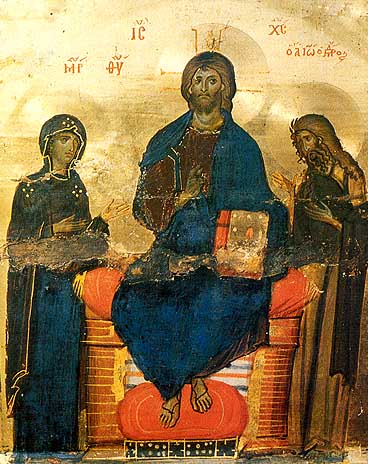Deesis on:
[Wikipedia]
[Google]
[Amazon]

 In Byzantine art, and in later Eastern Orthodox art generally, the Deësis or Deisis (, ; el, δέησις, "prayer" or "supplication"), is a traditional iconic representation of Christ in Majesty or Christ Pantocrator: enthroned, carrying a book, and flanked by the Virgin Mary and
In Byzantine art, and in later Eastern Orthodox art generally, the Deësis or Deisis (, ; el, δέησις, "prayer" or "supplication"), is a traditional iconic representation of Christ in Majesty or Christ Pantocrator: enthroned, carrying a book, and flanked by the Virgin Mary and
File:Triptych Harbaville Louvre OA3247 recto.jpg, Harbaville Triptych, middle of the 10th century, ivory, Constantinople, Louvre
File:Iconostasis in Moscow.jpg, Five-panel Deesis row (center),
Definition of Deesis
Byzantine art Iconography of Jesus Virgin Mary in art Eastern Orthodox icons

 In Byzantine art, and in later Eastern Orthodox art generally, the Deësis or Deisis (, ; el, δέησις, "prayer" or "supplication"), is a traditional iconic representation of Christ in Majesty or Christ Pantocrator: enthroned, carrying a book, and flanked by the Virgin Mary and
In Byzantine art, and in later Eastern Orthodox art generally, the Deësis or Deisis (, ; el, δέησις, "prayer" or "supplication"), is a traditional iconic representation of Christ in Majesty or Christ Pantocrator: enthroned, carrying a book, and flanked by the Virgin Mary and St. John the Baptist
John the Baptist or , , or , ;Wetterau, Bruce. ''World history''. New York: Henry Holt and Company. 1994. syc, ܝܘܿܚܲܢܵܢ ܡܲܥܡܕ݂ܵܢܵܐ, Yoḥanān Maʿmḏānā; he, יוחנן המטביל, Yohanān HaMatbil; la, Ioannes Bapti ...
, and sometimes other saints and angels. Mary and John, and any other figures, are shown facing towards Christ with their hands raised in supplication on behalf of humanity.
Early examples often appeared on the templon beam in Orthodox churches or above doors, though icons and devotional ivories also feature the Deesis.
After the development of the full iconostasis
In Eastern Christianity, an iconostasis ( gr, εἰκονοστάσιον) is a wall of icons and religious paintings, separating the nave from the sanctuary in a Church (building), church. ''Iconostasis'' also refers to a portable icon stand t ...
screen there was room for a larger "Deesis row" or "Great Deesis" of full-length figures, and the number of figures expanded, both in Byzantium and in Russia. Usually this row is above the level of the doors, and usually below (sometimes above) the row depicting the Twelve Great Feasts. The central Christ is therefore above the main door in the screen. Soon seven figures, usually one to a panel, became standard, in order of proximity to Christ in the centre: on the left (Christ's right) Mary, the Archangel Michael and Saint Peter, and on the right John the Baptist, the Archangel Gabriel and Saint Paul
Paul; grc, Παῦλος, translit=Paulos; cop, ⲡⲁⲩⲗⲟⲥ; hbo, פאולוס השליח (previously called Saul of Tarsus;; ar, بولس الطرسوسي; grc, Σαῦλος Ταρσεύς, Saũlos Tarseús; tr, Tarsuslu Pavlus; ...
. Especially in Russian examples, a number of saints of local significance are often included behind these, as space allows. Andrey Rublev's row for the Cathedral of the Dormition in Vladimir was 3.14 metres (over ten feet) high.Maria Cheremeteff in Leong, Albert ed.; ''The Millennium: Christianity and Russia, A.D. 988–1988''; pp. 110–118; 1990; St Vladimir's Seminary Press; In the Greek tradition the Apostles are more likely to occupy extra panels.
The presence of Mary and John, and other figures, provides one of the differences with the Western ''Christ in Majesty'', where the Four Evangelists and/or their symbols are more commonly included around Christ. The Deesis composition is also commonly found in the West, especially in those parts of Italy which came under Byzantine influence, but also in the rest of Europe. It often forms part of a scene of the Last Judgement. The use of the image declined slowly throughout the Middle Ages, and it is never as common as the Western forms of Christ in Majesty.
In depictions of the Crucifixion of Jesus, Christ on the cross is also very often flanked by the Virgin standing on one side, but by Saint John the Evangelist on the other, not by John the Baptist.
Gallery
Iconostasis
In Eastern Christianity, an iconostasis ( gr, εἰκονοστάσιον) is a wall of icons and religious paintings, separating the nave from the sanctuary in a Church (building), church. ''Iconostasis'' also refers to a portable icon stand t ...
in the Cathedral of the Annunciation in Moscow Kremlin
The Kremlin ( rus, Московский Кремль, r=Moskovskiy Kreml', p=ˈmɐˈskofskʲɪj krʲemlʲ, t=Moscow Kremlin) is a fortified complex in the center of Moscow founded by the Rurik dynasty. It is the best known of the kremlins (R ...
by Theophanes the Greek, 1405 – the first five-row Iconostasis
File:Cathedral Uglich inside 01.jpg, A larger Russian deesis row; Uglich Cathedral
File:Deesis_mosaic_Hagia_Sophia.jpg, Mosaic of the Deesis, 13th century, Hagia Sophia
References
{{reflistExternal links
Definition of Deesis
Byzantine art Iconography of Jesus Virgin Mary in art Eastern Orthodox icons